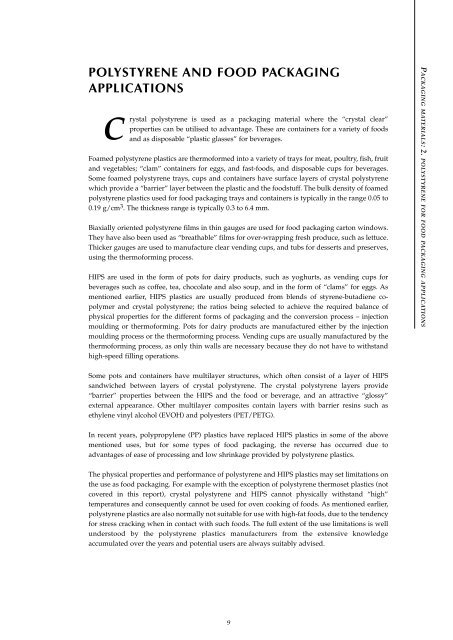packaging materials 2. polystyrene for food packaging applications
packaging materials 2. polystyrene for food packaging applications
packaging materials 2. polystyrene for food packaging applications
Create successful ePaper yourself
Turn your PDF publications into a flip-book with our unique Google optimized e-Paper software.
POLYSTYRENE AND FOOD PACKAGING<br />
APPLICATIONS<br />
C<br />
rystal <strong>polystyrene</strong> is used as a <strong>packaging</strong> material where the “crystal clear”<br />
properties can be utilised to advantage. These are containers <strong>for</strong> a variety of <strong>food</strong>s<br />
and as disposable “plastic glasses” <strong>for</strong> beverages.<br />
Foamed <strong>polystyrene</strong> plastics are thermo<strong>for</strong>med into a variety of trays <strong>for</strong> meat, poultry, fish, fruit<br />
and vegetables; “clam” containers <strong>for</strong> eggs, and fast-<strong>food</strong>s, and disposable cups <strong>for</strong> beverages.<br />
Some foamed <strong>polystyrene</strong> trays, cups and containers have surface layers of crystal <strong>polystyrene</strong><br />
which provide a “barrier” layer between the plastic and the <strong>food</strong>stuff. The bulk density of foamed<br />
<strong>polystyrene</strong> plastics used <strong>for</strong> <strong>food</strong> <strong>packaging</strong> trays and containers is typically in the range 0.05 to<br />
0.19 g/cm 3 . The thickness range is typically 0.3 to 6.4 mm.<br />
Biaxially oriented <strong>polystyrene</strong> films in thin gauges are used <strong>for</strong> <strong>food</strong> <strong>packaging</strong> carton windows.<br />
They have also been used as “breathable” films <strong>for</strong> over-wrapping fresh produce, such as lettuce.<br />
Thicker gauges are used to manufacture clear vending cups, and tubs <strong>for</strong> desserts and preserves,<br />
using the thermo<strong>for</strong>ming process.<br />
HIPS are used in the <strong>for</strong>m of pots <strong>for</strong> dairy products, such as yoghurts, as vending cups <strong>for</strong><br />
beverages such as coffee, tea, chocolate and also soup, and in the <strong>for</strong>m of “clams” <strong>for</strong> eggs. As<br />
mentioned earlier, HIPS plastics are usually produced from blends of styrene-butadiene copolymer<br />
and crystal <strong>polystyrene</strong>; the ratios being selected to achieve the required balance of<br />
physical properties <strong>for</strong> the different <strong>for</strong>ms of <strong>packaging</strong> and the conversion process – injection<br />
moulding or thermo<strong>for</strong>ming. Pots <strong>for</strong> dairy products are manufactured either by the injection<br />
moulding process or the thermo<strong>for</strong>ming process. Vending cups are usually manufactured by the<br />
thermo<strong>for</strong>ming process, as only thin walls are necessary because they do not have to withstand<br />
high-speed filling operations.<br />
PACKAGING MATERIALS: <strong>2.</strong> POLYSTYRENE FOR FOOD PACKAGING APPLICATIONS<br />
Some pots and containers have multilayer structures, which often consist of a layer of HIPS<br />
sandwiched between layers of crystal <strong>polystyrene</strong>. The crystal <strong>polystyrene</strong> layers provide<br />
“barrier” properties between the HIPS and the <strong>food</strong> or beverage, and an attractive “glossy”<br />
external appearance. Other multilayer composites contain layers with barrier resins such as<br />
ethylene vinyl alcohol (EVOH) and polyesters (PET/PETG).<br />
In recent years, polypropylene (PP) plastics have replaced HIPS plastics in some of the above<br />
mentioned uses, but <strong>for</strong> some types of <strong>food</strong> <strong>packaging</strong>, the reverse has occurred due to<br />
advantages of ease of processing and low shrinkage provided by <strong>polystyrene</strong> plastics.<br />
The physical properties and per<strong>for</strong>mance of <strong>polystyrene</strong> and HIPS plastics may set limitations on<br />
the use as <strong>food</strong> <strong>packaging</strong>. For example with the exception of <strong>polystyrene</strong> thermoset plastics (not<br />
covered in this report), crystal <strong>polystyrene</strong> and HIPS cannot physically withstand “high”<br />
temperatures and consequently cannot be used <strong>for</strong> oven cooking of <strong>food</strong>s. As mentioned earlier,<br />
<strong>polystyrene</strong> plastics are also normally not suitable <strong>for</strong> use with high-fat <strong>food</strong>s, due to the tendency<br />
<strong>for</strong> stress cracking when in contact with such <strong>food</strong>s. The full extent of the use limitations is well<br />
understood by the <strong>polystyrene</strong> plastics manufacturers from the extensive knowledge<br />
accumulated over the years and potential users are always suitably advised.<br />
9

















